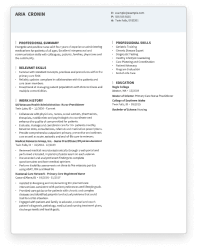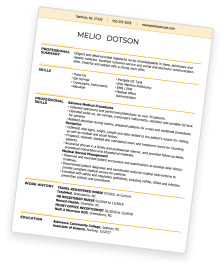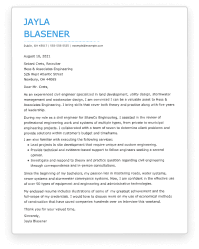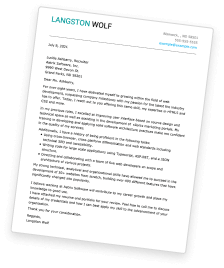Solutions Architect Resumes: Overview
Solutions architects are the masterminds behind designing and implementing complex solutions that address the unique technological challenges faced by organizations. They are pivotal in bridging the gap between business objectives and IT capabilities.
Solutions architects can be found in a variety of companies, including:
- Enterprise IT
- Cloud Service Providers
- Tech Consulting Firms
- Startups
As a solutions architect, you’ll be responsible for architecting systems, optimizing workflows, and ensuring that technology solutions align with an organization’s goals.
With our resume samples for solutions architects, you can create a great resume and begin to set your career in a new direction. For more guidance, check out our collection of customizable resume examples and downloadable templates today!
Solutions Architect Resume Example
Use this resume sample the next time you apply for a solutions architect position. With an intriguing design and thorough qualifications, it is a great resume-writing template.
-
Engaging Header:
The colorful header with bold typeface also includes the candidate's name and contact information in a clear and organized manner to keep this solutions architect resume looking professional.
-
Results Oriented:
The work history section is filled with responsibilities and achievements that showcase the impact of the candidate in their experience as a solutions architect.
-
Quantifiable Experience:
In addition to focusing on results, the work experience can be measured with specific data, such as improving functionality by 35%, which provides unique contextual value.
-
Consistent Formatting:
Throughout this resume example there is a consistency in the use of typefaces and font sizes, as wells as organizational orientation, that ensures easy readability.
Solutions Architect Resume Sample
This sample of a solutions architect resume sets a high standard for professional design and relevant qualifications, making it a great template for you to use.
-
Clean Layout:
The effective use of whitespace, combined with a subtle hint of color in the header, keeps this resume easy to read for employers.
-
Quality Summary:
The resume starts off with a helpful resume summary that perfectly sums up what makes this candidate the best choice choice for the solutions architect position.
-
Detailed Work History:
The work history section provides comprehensive details about the candidate's relevant experience in solutions architecture, highlighting achievements and responsibilities.
-
Relevant Skills:
Relevant skills, such as scrum and agile proficiency, help make this resume stand out, especially for applicant tracking systems (ATS) looking for solutions architecture keywords.
How to Write a Solutions Architect Resume: A Step-by-Step Guide
Writing an effective resume is crucial to getting a job as a solution architect. Use this step-by-step guide to help you craft a professional quality resume that showcases your best qualifications for the position.
-
Choose a Format:
When building your solutions architect resume, you've got a range of options at your disposal. Explore the various resume formats available and choose the one that aligns best with your requirements. The chronological resume format stands as the most prevalent choice, with its primary focus on your work history.
On the other hand, the functional resume format provides an alternative strategy. Although it's less common and may not be as ATS-friendly, it can be an excellent option, especially for those with limited experience. Recent high school graduates, for instance, can capitalize on its emphasis on transferable skills. Lastly, there's the combination resume format, incorporating elements from both the chronological and functional approaches.
-
Contact Information:
Start your resume with the proper contact information that clearly establishes who you are and how you can be reached. Include your full name, professional email address, and phone number. A LinkedIn profile or professional website address is also optional.
-
Summary or Objective:
Kickstart your resume with a powerful summary or objective statement. A resume summary, typically 2-3 sentences, highlights your relevant experience, skills, and what you bring to the role.
An objective statement outlines your career goals and how they align with the position you're pursuing. Choose the one that best suits your situation and customize it for each specific job application.
-
Work History:
Showcase your value with details about relevant work experience, including your job title, the name of your employer, the dates you were employed, location, and key responsibilities and achievements. Quantify your information as much as possible to add unique value to your solutions architect resume.
-
Skills:
List a combination of hard and soft skills that are specific to the solutions architect position so that your resume has a better chance to stand out with the reader and applicant tracking systems.
-
Education:
List your educational background, focusing on the highest degree obtained and relevant coursework or certifications. Provide the name of the institution, the degree or certificate obtained, and the location.
-
Additional Sections (optional):
Consider adding any other relevant information in additional sections, such as for professional associations related to solutions architecture, awards, and volunteer work.
To excel as a solutions architect, you must possess a diverse skill set and relevant certifications demonstrating your expertise. Here, we outline the top hard skills, soft skills, and certifications that will make your solutions architect resume shine.
Top 5 Hard Skills for Solutions Architects
- Cloud Computing Proficiency: Mastery of cloud platforms like AWS, Azure, or Google Cloud is crucial for architecting scalable and cost-effective solutions in the modern tech landscape.
- Programming and Scripting Languages: Proficiency in languages like Java, Python, JavaScript, or SQL enables you to design and implement robust solutions.
- Architecture Frameworks: Understanding and applying architecture frameworks such as TOGAF or Zachman helps structure complex systems effectively.
- Security Expertise: Knowledge of security principles and best practices is essential to ensure that solutions are secure and compliant with industry standards.
- Networking Knowledge: Understanding network protocols, routing, and load balancing is vital for optimizing system performance and reliability.
Top 5 Soft Skills for Solutions Architects
- Communication: Effective communication is paramount to convey technical information to technical and non-technical stakeholders.
- Problem-Solving: Solutions architects must identify and solve complex problems efficiently.
- Leadership: Strong leadership skills are essential for guiding development teams and ensuring project success.
- Adaptability: Adapting to evolving technologies and requirements is critical in the dynamic field of solutions architecture.
- Client-Centric Approach: Solutions architects should be client-focused, understanding business needs, and aligning technology solutions accordingly.
Top 5 Certifications for Solutions Architects
- AWS Certified Solutions Architect: This certification from Amazon Web Services validates your expertise in designing distributed systems on AWS.
- Microsoft Certified: Azure Solutions Architect: Ideal for Azure enthusiasts, this certification proves your skills in designing solutions on Microsoft’s cloud platform.
- Google Cloud Professional Cloud Architect: For those proficient in Google Cloud, this certification demonstrates your ability to design and manage scalable cloud solutions.
- TOGAF (The Open Group Architecture Framework): This certification showcases your knowledge of enterprise architecture and its application.
- Certified Information Systems Security Professional (CISSP): Valuable for solutions architects focusing on security, CISSP certification demonstrates expertise in information security management.
Unsurprisingly, incorporating computer skills and technical proficiencies is key to demonstrating you are a qualified solutions architect on your resume. Take these skills and tailor your resume to impress potential employers and secure your desired role as a solutions architect.
Helping Job Seekers Like You
10 Tips For Writing a Solutions Architect Resume
- Tailor Your Resume for the Job: Customize your resume for each position you apply for, highlighting the skills and experiences most relevant to the specific job description.
- Start with a Strong Summary: Start your resume with a captivating summary highlighting your expertise, key accomplishments, and career goals.
- Showcase Achievements, Not Just Responsibilities: Use bullet points to detail your accomplishments in previous roles, emphasizing your measurable impact on projects and organizations.
- Highlight Technical Skills: Devote a section to your technical skills, listing programming languages, architecture frameworks, and cloud platforms you’re proficient in.
- Quantify Your Achievements: Whenever possible, use metrics and data to quantify your accomplishments, such as increased efficiency, reduced costs, or improved system performance.
- Emphasize Soft Skills: Clearly communicate your soft skills like communication, problem-solving, and leadership, which are equally important for a solutions architect.
- Incorporate Relevant Keywords: Include industry-specific keywords in your resume to increase its visibility in applicant tracking systems (ATS).
- Use a Clean and Readable Format: Ensure your resume is easy to read with a clean layout, consistent formatting, and professional fonts.
- Prioritize Certifications: Place your certifications prominently, as they validate your expertise and can grab the attention of hiring managers.
- Include a Projects Section: If applicable, create a section highlighting key projects you’ve worked on, describing your role and contributions.
- Keep It Concise: While showcasing your skills and experiences is essential, keep your resume concise and limit it to 1-2 pages.
- Proofread and Edit: Thoroughly proofread your resume to eliminate any grammar, spelling, or formatting errors. Consider seeking feedback from peers or mentors.


Save Time With Hloom's Resume Builder
Key Takeaways
Tailoring your solutions architect resume to match the job description is essential. Highlight relevant skills, experiences, and certifications to demonstrate your suitability for the role.
Solution architects should emphasize both hard and soft skills. Technical skills in cloud computing, programming languages, and architecture frameworks are crucial but don't forget to showcase essential soft skills like communication and problem-solving.
Including relevant certifications such as AWS Certified Solutions Architect or TOGAF can boost your credibility and make your resume stand out to potential employers.
Highlight your achievements, quantify your impact, and make sure your resume aligns with the unique demands of the solutions architect role to increase your chances of landing your dream job in this field.
Save Time With Hloom's Cover Letter Builder


Solutions Architect Resume FAQ
Additionally, create a dedicated section for technical skills and list programming languages, cloud platforms, architecture frameworks, and other relevant tools you're proficient in. Be specific, and if possible, mention any certifications related to these skills.




